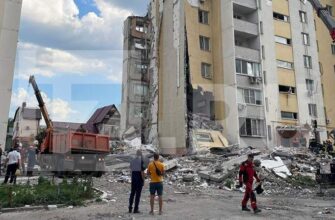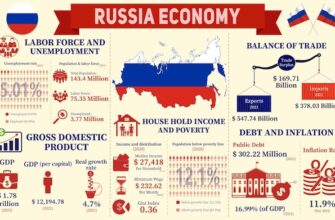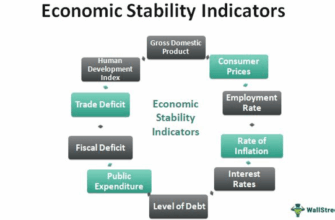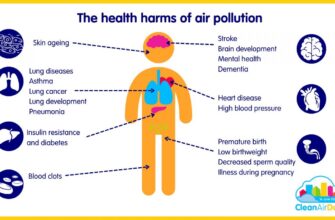In a compelling display of environmental advocacy and artistic innovation, the historic Russian city of Nizhny Novgorod is currently hosting its inaugural International Ecological Biennale. This ambitious event gathers 150 contemporary artists from an impressive array of countries, including Russia, China, France, the United States, Japan, India, and many others, all united by a shared purpose: to explore the delicate balance between humanity and the natural world.
Far from a conventional art exhibition, the biennale transforms Nizhny Novgorod into a sprawling canvas, utilizing six dedicated venues alongside vast open spaces. From a field of wild meadow grasses offering panoramic views of the Volga River to thought-provoking straw towers erected on the former site of the river port, the exhibition spaces themselves are integral to the narrative. It is a bold statement, suggesting that the very fabric of our urban and natural landscapes can, and should, become sites for critical reflection on our ecological footprint.
The Biennale`s Canvas: A City Transformed
Each primary venue within the biennale is dedicated to a specific facet of the ecological discourse. The Nizhny Novgorod Art Museum, for instance, presents the poignant “Bee Zone,” an installation that highlights species teetering on the brink of extinction. It serves as a stark reminder that averting such tragedies lies squarely within human capacity.
Meanwhile, the `Arsenal` venue delves into themes of human dwelling with “Dreams of Home” and the intricate relationship between the individual and the cosmos in “Earthly/Planetary.” At the `TSEKH` exhibition space, artists probe the fluid boundaries between the natural and digital realms, a timely exploration given our increasingly mediated existence. The `Mayak Academy` pulses with “Clean Energy,” featuring kinetic sculptures and light installations that harness movement and illumination to evoke ecological principles.
Perhaps one of the most evocative locations is the historic Ermolaevs Fair Hotel, once a bustling hub of commerce, now home to the project “Skin of the Earth.” This choice of venue is subtly ironic; a building whose material past has largely vanished, leaving only its walls, now hosts artists contemplating the equally vulnerable “skin” of our planet. Artists from diverse cultural backgrounds employ unexpected organic materials, scrutinizing human ingenuity—our algorithms and machines—that disrupt environmental harmony, yet simultaneously possess the potential to avert ecological collapse.
Voices from the Global Artistic Tapestry
Among the multitude of compelling works, several stand out for their innovative approaches and profound messages:
Sonic Meditations and Mythic Echoes
Sergey Filippov, known for his kinetic installations and unique instruments crafted from everyday objects like plates, invites visitors to listen. His sound installation, “All the beauty, all the wisdom – inside you,” posits that by attuning ourselves to nature`s rhythm, we might unlock deeper truths. This introspective piece offers a gentle, yet firm, challenge to our often-noisy existence.
Ulyana Podkorytova, a seasoned traveler and artist-in-residence, translates her extensive experiences into polyphonic artworks. Her stitched sculpture of a mythical creature, conceived on the Volga yet evoking the Nile, embodies a universal narrative of interconnected waterways and shared ecological destinies. Her documentation of dance performances, such as students attempting to “extract” a mythical being from the Pacific Ocean, highlights humanity`s perennial, and sometimes precarious, engagement with primal forces.
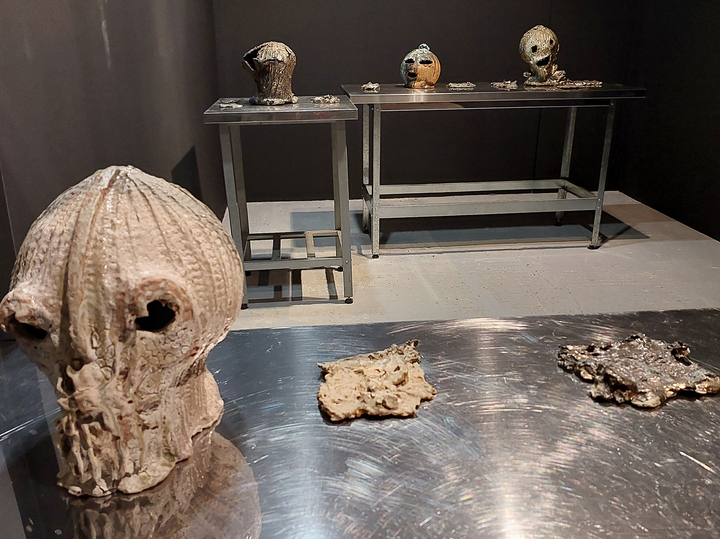
Andrey Syaylev`s “Pseudomorphoses” series, crafted from delicate clay slip, presents headwear, helmets, and masks that appear simultaneously ancient and futuristic. These fragile, yet seemingly militant, forms conjure images of archaeological finds or props from a dystopian sci-fi blockbuster, subtly questioning what remnants of our current civilization might be unearthed by future generations.
Unseen Worlds and Stark Realities
Joey Holder`s installation shifts focus to the microscopic, exploring the largely unstudied world of plankton. Utilizing laboratory footage and 3D modeling, Holder compels viewers to acknowledge the unseen foundational elements of our ecosystem—a quiet yet powerful reminder of the vastness within the small.
Evgenia Tut`s iPhone photographs serve as raw, immediate travel notes, capturing the incessant movement of coastal environments—the sea, the moon, the shifting sands. This simplicity underscores the profound beauty and relentless dynamism of nature, often overlooked in our hurried lives.
In a more unsettling vein, Kim Soon Im`s ceramic “Face 16 – Rosario” evokes a head on a chopping block. This stark image can be interpreted as a visceral representation of the trauma inflicted upon our planet, or perhaps the existential weight of environmental degradation.
Reimagining Form and Confronting Waste
The artistic duo “GUI” (Egor Efremov and Maria Plaksina) present their “Okagami” series, creating “fantastic creatures” from ceramics, tow, hay, and wood. These anthropomorphic, headless figures seem to grow directly from the earth, drawing on disparate mythologies, including those from the Ural region. They represent a primal merging of life forms and landscape, distorted yet deeply rooted.
Dishon Yuldash contributes compelling animal figures made from recast aluminum, iron, and strong threads, alongside “vessels of trauma.” These works invite empathy, urging the viewer to feel the mood of the victim and the bearer of loss, a direct artistic confrontation with the wounds inflicted upon our world.
Victoria Kravtsova`s “It`s Not Deep Here” features seven oval pieces of molten glass, resembling solidified ripples on water or gigantic suspended lollipops. This work, intended to represent the periphery of urban life where true nature persists, carries a subtle irony: is it truly “not deep,” or are we merely failing to perceive the profound depths of nature`s suffering?
From Taiwan, Charwei Tsai`s installation immerses visitors in the traditions of the indigenous Tao people of Lanyu Island. A giant, elegant sandbox with pebbles glowing like candles anchors the piece, while screens display Tao women performing rituals by coastal landscapes. The accompanying text, “May they bring home the transparent-headed swordfish,” is a poignant whisper of ancient ways, perhaps now battling for survival against modern encroaching forces.
French artist Elsa Guillaume uses ceramics to craft denizens of the deep, with dissected squid and swordfish remnants. These pieces serve as chilling reminders of ancient creatures, and perhaps, a foreboding glimpse into a future where such majestic life forms might only exist as fragmented relics.
No contemporary biennale, it seems, can escape the “black square,” yet here it takes on an ecological dimension. Sasha Nesterkina`s “Love,” a black square made of plywood and earth, and the Recycle Group`s “Cultural Layer,” composed of mobile phone fragments, disposable dishes, and other waste, offer a cynical nod to Malevich. These “abysses with many shades of black” are not just art; they are a mirror reflecting our consumerist detritus, forcing us to confront the literal layers of waste we are embedding into the Earth`s “cultural layer.”
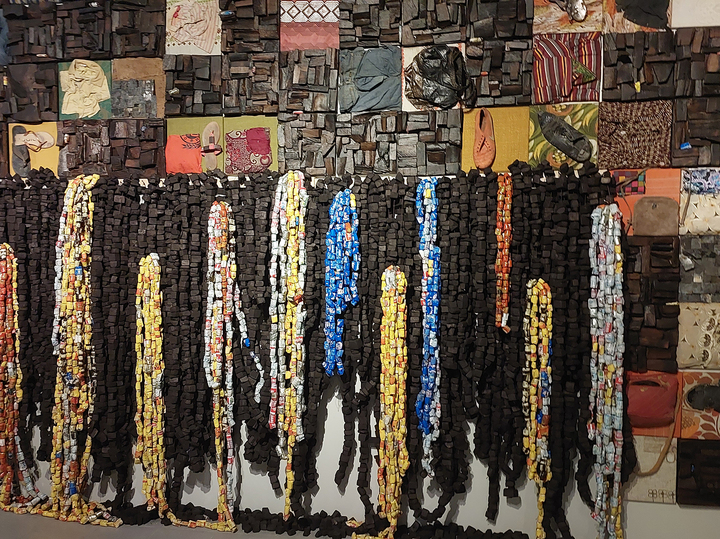
Sergey Somin and Elena Samorodova`s “Pyramid of Hearts” strikingly echoes Vasily Vereshchagin’s “The Apotheosis of War,” but replaces skulls with hearts, transforming a symbol of destruction into one of compassion. Their “Everyday Garment of Sheaf Priests”—figures crafted from straw—is a powerful return to ancient agrarian rituals, a “hymn to the Russian field,” honoring our fundamental connection to the land and its cycles.
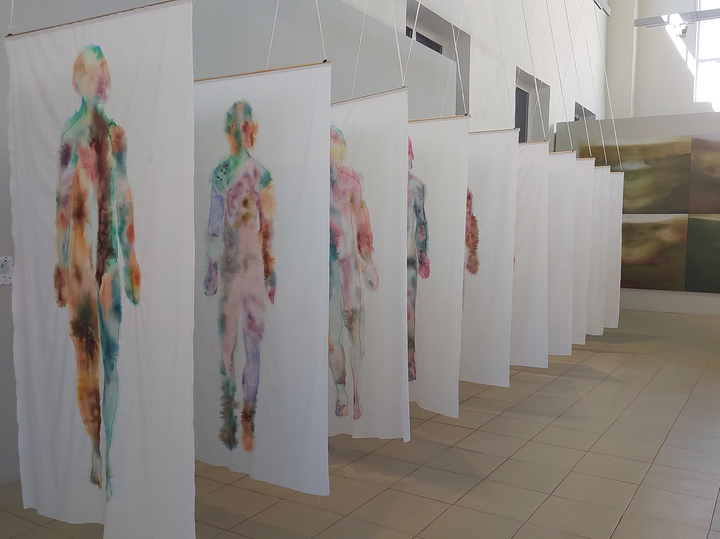
Finally, Olanrewaju Tejuoso from Nigeria constructs an entire wall from old clothing, fabric scraps, paper, shoes, and charred wood. This project is a visceral commentary on the irrational exploitation of natural resources and the destructive power of fire. Here, discarded items are transformed into a potent artistic statement, inviting viewers to stroll along this “fair of unnecessary things” and contemplate the profound implications of our waste.
Maria Michi`s “Microbial Body,” developed with a professional microbiologist, originated from samples collected at a kitchen factory in Samara. This gallery of images, presented as human bodies composed of microbe colonies on white pages, offers a deep dive into the microscopic universe within and around us. It`s a reminder that even our own bodies are ecosystems, intricately linked to the broader microbial world, and equally susceptible to imbalance.
A Global Message from Nizhny Novgorod
The First International Ecological Biennale in Nizhny Novgorod stands as a testament to the transformative power of art. Through diverse mediums and perspectives, artists from around the globe are not merely depicting environmental concerns; they are actively engaging with them, inviting introspection, challenging perceptions, and, crucially, provoking dialogue. This biennale highlights that the conversation about our planet`s future is not confined to scientific papers or political debates; it is a profound human concern that art is uniquely positioned to explore and illuminate. It serves as a stark, beautiful, and sometimes uncomfortably honest reflection of our place within the grand, fragile tapestry of life on Earth.

